B207A: IKEA's Marketing and Operations Strategy Analysis
VerifiedAdded on 2023/01/18
|6
|1475
|58
Report
AI Summary
This report provides a comprehensive analysis of IKEA's business strategies, including its competitive, marketing, and operational approaches. It highlights IKEA's cost leadership strategy, which focuses on offering affordable furniture by minimizing costs through economies of scale and technological integration. The report delves into IKEA's marketing strategy, emphasizing its differentiated approach to meet customer demands and its positioning as a value-based company targeting young adults and business people. It details the marketing mix elements, including product range, pricing strategies, distribution networks, and promotional activities. Furthermore, the report examines IKEA's operational strategy, highlighting its ability to manage high volumes of standardized products with low customer contact. Finally, it establishes the interconnectedness of competitive, marketing, and operational strategies in achieving IKEA's overall success. The report concludes by emphasizing the importance of a robust operational strategy for maintaining IKEA's market position and attracting and retaining customers.
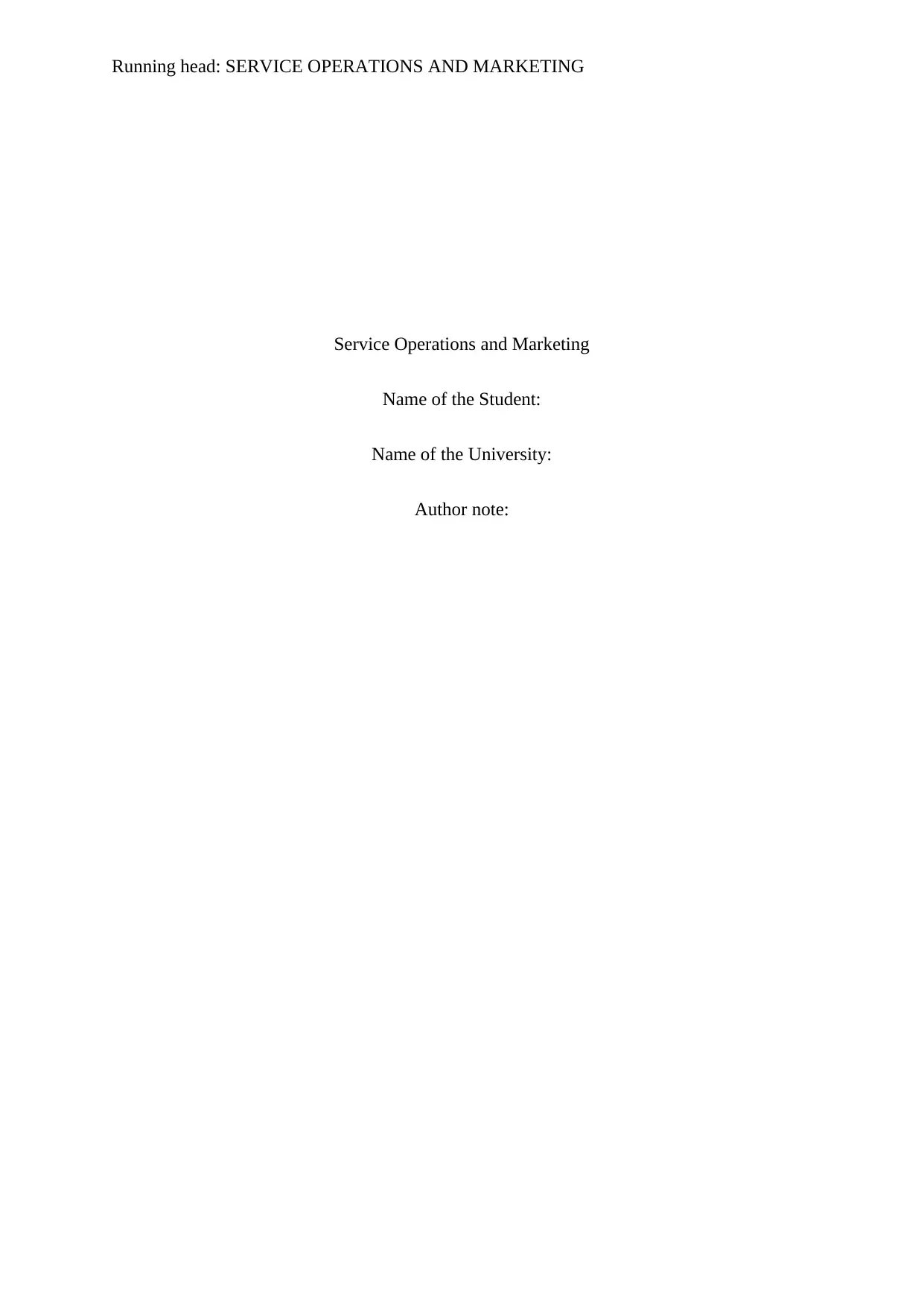
Running head: SERVICE OPERATIONS AND MARKETING
Service Operations and Marketing
Name of the Student:
Name of the University:
Author note:
Service Operations and Marketing
Name of the Student:
Name of the University:
Author note:
Paraphrase This Document
Need a fresh take? Get an instant paraphrase of this document with our AI Paraphraser
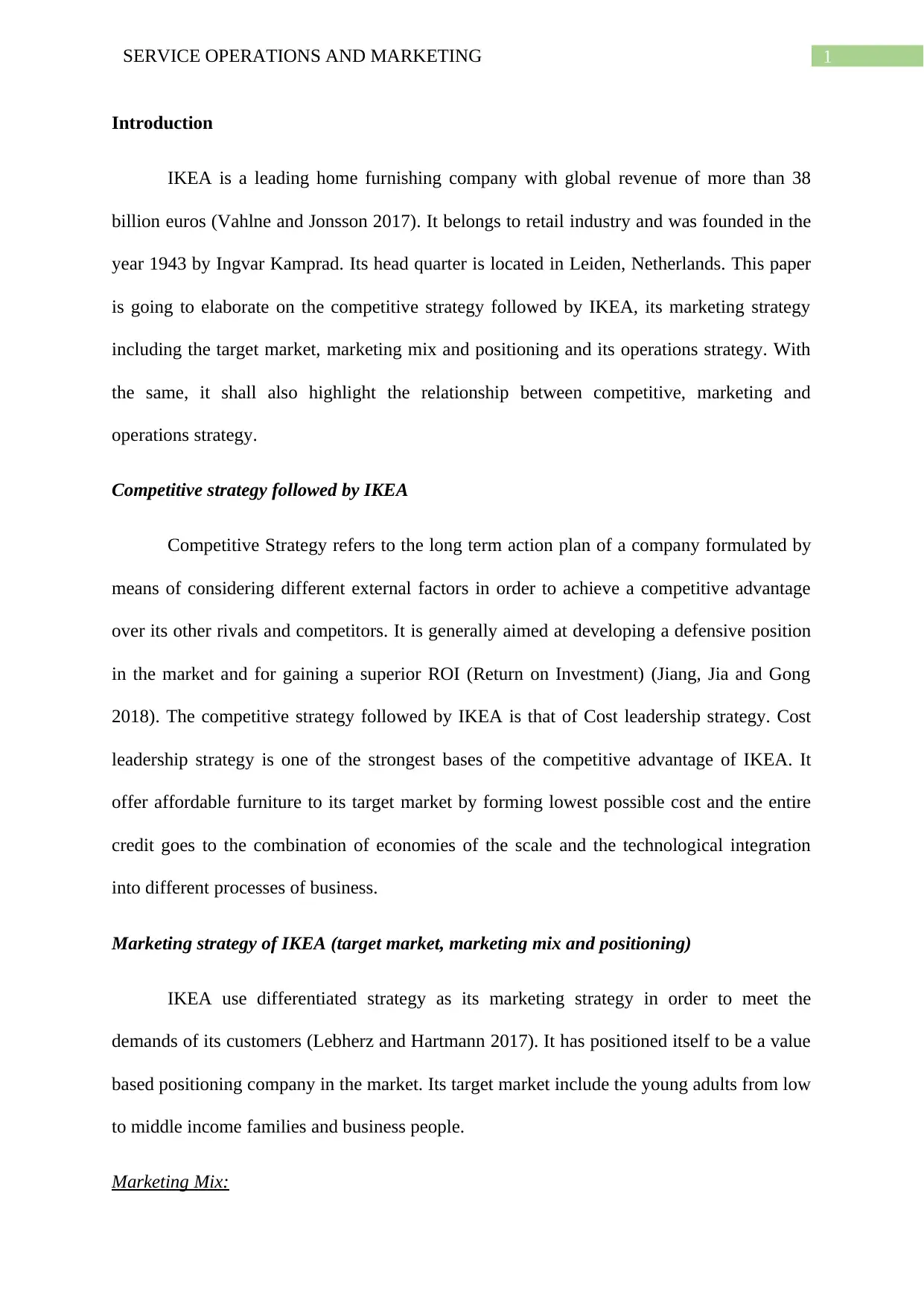
1SERVICE OPERATIONS AND MARKETING
Introduction
IKEA is a leading home furnishing company with global revenue of more than 38
billion euros (Vahlne and Jonsson 2017). It belongs to retail industry and was founded in the
year 1943 by Ingvar Kamprad. Its head quarter is located in Leiden, Netherlands. This paper
is going to elaborate on the competitive strategy followed by IKEA, its marketing strategy
including the target market, marketing mix and positioning and its operations strategy. With
the same, it shall also highlight the relationship between competitive, marketing and
operations strategy.
Competitive strategy followed by IKEA
Competitive Strategy refers to the long term action plan of a company formulated by
means of considering different external factors in order to achieve a competitive advantage
over its other rivals and competitors. It is generally aimed at developing a defensive position
in the market and for gaining a superior ROI (Return on Investment) (Jiang, Jia and Gong
2018). The competitive strategy followed by IKEA is that of Cost leadership strategy. Cost
leadership strategy is one of the strongest bases of the competitive advantage of IKEA. It
offer affordable furniture to its target market by forming lowest possible cost and the entire
credit goes to the combination of economies of the scale and the technological integration
into different processes of business.
Marketing strategy of IKEA (target market, marketing mix and positioning)
IKEA use differentiated strategy as its marketing strategy in order to meet the
demands of its customers (Lebherz and Hartmann 2017). It has positioned itself to be a value
based positioning company in the market. Its target market include the young adults from low
to middle income families and business people.
Marketing Mix:
Introduction
IKEA is a leading home furnishing company with global revenue of more than 38
billion euros (Vahlne and Jonsson 2017). It belongs to retail industry and was founded in the
year 1943 by Ingvar Kamprad. Its head quarter is located in Leiden, Netherlands. This paper
is going to elaborate on the competitive strategy followed by IKEA, its marketing strategy
including the target market, marketing mix and positioning and its operations strategy. With
the same, it shall also highlight the relationship between competitive, marketing and
operations strategy.
Competitive strategy followed by IKEA
Competitive Strategy refers to the long term action plan of a company formulated by
means of considering different external factors in order to achieve a competitive advantage
over its other rivals and competitors. It is generally aimed at developing a defensive position
in the market and for gaining a superior ROI (Return on Investment) (Jiang, Jia and Gong
2018). The competitive strategy followed by IKEA is that of Cost leadership strategy. Cost
leadership strategy is one of the strongest bases of the competitive advantage of IKEA. It
offer affordable furniture to its target market by forming lowest possible cost and the entire
credit goes to the combination of economies of the scale and the technological integration
into different processes of business.
Marketing strategy of IKEA (target market, marketing mix and positioning)
IKEA use differentiated strategy as its marketing strategy in order to meet the
demands of its customers (Lebherz and Hartmann 2017). It has positioned itself to be a value
based positioning company in the market. Its target market include the young adults from low
to middle income families and business people.
Marketing Mix:
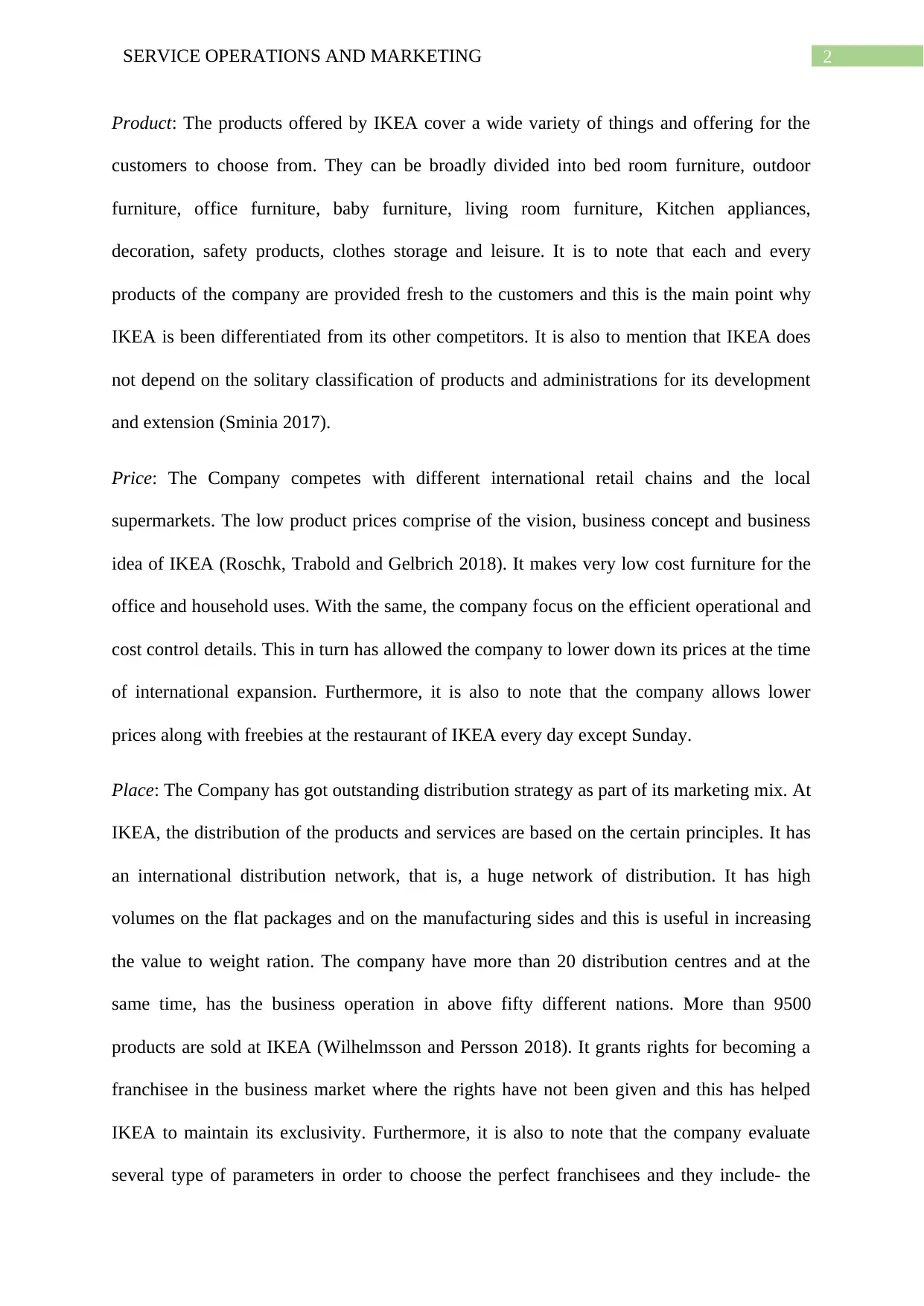
2SERVICE OPERATIONS AND MARKETING
Product: The products offered by IKEA cover a wide variety of things and offering for the
customers to choose from. They can be broadly divided into bed room furniture, outdoor
furniture, office furniture, baby furniture, living room furniture, Kitchen appliances,
decoration, safety products, clothes storage and leisure. It is to note that each and every
products of the company are provided fresh to the customers and this is the main point why
IKEA is been differentiated from its other competitors. It is also to mention that IKEA does
not depend on the solitary classification of products and administrations for its development
and extension (Sminia 2017).
Price: The Company competes with different international retail chains and the local
supermarkets. The low product prices comprise of the vision, business concept and business
idea of IKEA (Roschk, Trabold and Gelbrich 2018). It makes very low cost furniture for the
office and household uses. With the same, the company focus on the efficient operational and
cost control details. This in turn has allowed the company to lower down its prices at the time
of international expansion. Furthermore, it is also to note that the company allows lower
prices along with freebies at the restaurant of IKEA every day except Sunday.
Place: The Company has got outstanding distribution strategy as part of its marketing mix. At
IKEA, the distribution of the products and services are based on the certain principles. It has
an international distribution network, that is, a huge network of distribution. It has high
volumes on the flat packages and on the manufacturing sides and this is useful in increasing
the value to weight ration. The company have more than 20 distribution centres and at the
same time, has the business operation in above fifty different nations. More than 9500
products are sold at IKEA (Wilhelmsson and Persson 2018). It grants rights for becoming a
franchisee in the business market where the rights have not been given and this has helped
IKEA to maintain its exclusivity. Furthermore, it is also to note that the company evaluate
several type of parameters in order to choose the perfect franchisees and they include- the
Product: The products offered by IKEA cover a wide variety of things and offering for the
customers to choose from. They can be broadly divided into bed room furniture, outdoor
furniture, office furniture, baby furniture, living room furniture, Kitchen appliances,
decoration, safety products, clothes storage and leisure. It is to note that each and every
products of the company are provided fresh to the customers and this is the main point why
IKEA is been differentiated from its other competitors. It is also to mention that IKEA does
not depend on the solitary classification of products and administrations for its development
and extension (Sminia 2017).
Price: The Company competes with different international retail chains and the local
supermarkets. The low product prices comprise of the vision, business concept and business
idea of IKEA (Roschk, Trabold and Gelbrich 2018). It makes very low cost furniture for the
office and household uses. With the same, the company focus on the efficient operational and
cost control details. This in turn has allowed the company to lower down its prices at the time
of international expansion. Furthermore, it is also to note that the company allows lower
prices along with freebies at the restaurant of IKEA every day except Sunday.
Place: The Company has got outstanding distribution strategy as part of its marketing mix. At
IKEA, the distribution of the products and services are based on the certain principles. It has
an international distribution network, that is, a huge network of distribution. It has high
volumes on the flat packages and on the manufacturing sides and this is useful in increasing
the value to weight ration. The company have more than 20 distribution centres and at the
same time, has the business operation in above fifty different nations. More than 9500
products are sold at IKEA (Wilhelmsson and Persson 2018). It grants rights for becoming a
franchisee in the business market where the rights have not been given and this has helped
IKEA to maintain its exclusivity. Furthermore, it is also to note that the company evaluate
several type of parameters in order to choose the perfect franchisees and they include- the
⊘ This is a preview!⊘
Do you want full access?
Subscribe today to unlock all pages.

Trusted by 1+ million students worldwide
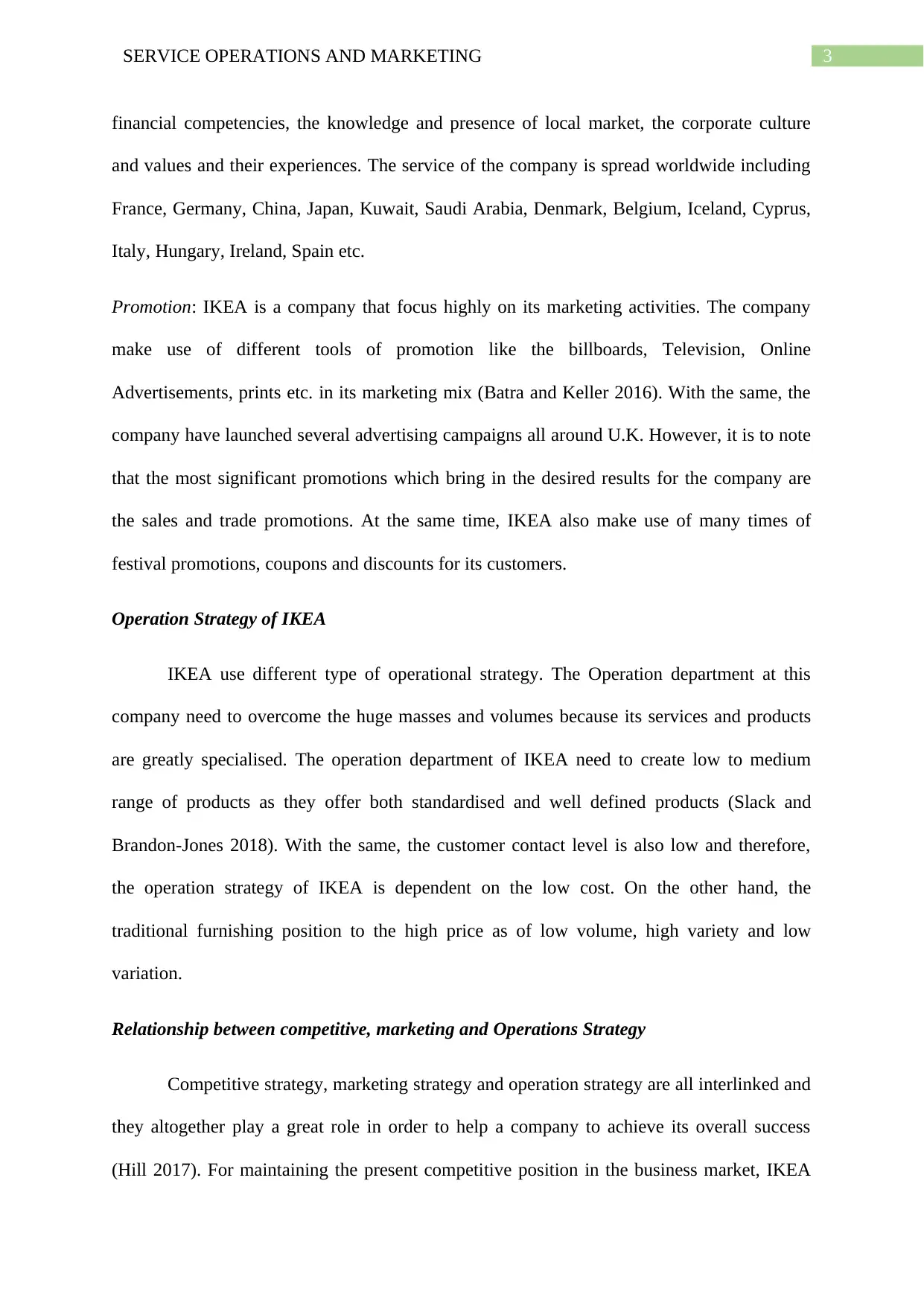
3SERVICE OPERATIONS AND MARKETING
financial competencies, the knowledge and presence of local market, the corporate culture
and values and their experiences. The service of the company is spread worldwide including
France, Germany, China, Japan, Kuwait, Saudi Arabia, Denmark, Belgium, Iceland, Cyprus,
Italy, Hungary, Ireland, Spain etc.
Promotion: IKEA is a company that focus highly on its marketing activities. The company
make use of different tools of promotion like the billboards, Television, Online
Advertisements, prints etc. in its marketing mix (Batra and Keller 2016). With the same, the
company have launched several advertising campaigns all around U.K. However, it is to note
that the most significant promotions which bring in the desired results for the company are
the sales and trade promotions. At the same time, IKEA also make use of many times of
festival promotions, coupons and discounts for its customers.
Operation Strategy of IKEA
IKEA use different type of operational strategy. The Operation department at this
company need to overcome the huge masses and volumes because its services and products
are greatly specialised. The operation department of IKEA need to create low to medium
range of products as they offer both standardised and well defined products (Slack and
Brandon-Jones 2018). With the same, the customer contact level is also low and therefore,
the operation strategy of IKEA is dependent on the low cost. On the other hand, the
traditional furnishing position to the high price as of low volume, high variety and low
variation.
Relationship between competitive, marketing and Operations Strategy
Competitive strategy, marketing strategy and operation strategy are all interlinked and
they altogether play a great role in order to help a company to achieve its overall success
(Hill 2017). For maintaining the present competitive position in the business market, IKEA
financial competencies, the knowledge and presence of local market, the corporate culture
and values and their experiences. The service of the company is spread worldwide including
France, Germany, China, Japan, Kuwait, Saudi Arabia, Denmark, Belgium, Iceland, Cyprus,
Italy, Hungary, Ireland, Spain etc.
Promotion: IKEA is a company that focus highly on its marketing activities. The company
make use of different tools of promotion like the billboards, Television, Online
Advertisements, prints etc. in its marketing mix (Batra and Keller 2016). With the same, the
company have launched several advertising campaigns all around U.K. However, it is to note
that the most significant promotions which bring in the desired results for the company are
the sales and trade promotions. At the same time, IKEA also make use of many times of
festival promotions, coupons and discounts for its customers.
Operation Strategy of IKEA
IKEA use different type of operational strategy. The Operation department at this
company need to overcome the huge masses and volumes because its services and products
are greatly specialised. The operation department of IKEA need to create low to medium
range of products as they offer both standardised and well defined products (Slack and
Brandon-Jones 2018). With the same, the customer contact level is also low and therefore,
the operation strategy of IKEA is dependent on the low cost. On the other hand, the
traditional furnishing position to the high price as of low volume, high variety and low
variation.
Relationship between competitive, marketing and Operations Strategy
Competitive strategy, marketing strategy and operation strategy are all interlinked and
they altogether play a great role in order to help a company to achieve its overall success
(Hill 2017). For maintaining the present competitive position in the business market, IKEA
Paraphrase This Document
Need a fresh take? Get an instant paraphrase of this document with our AI Paraphraser
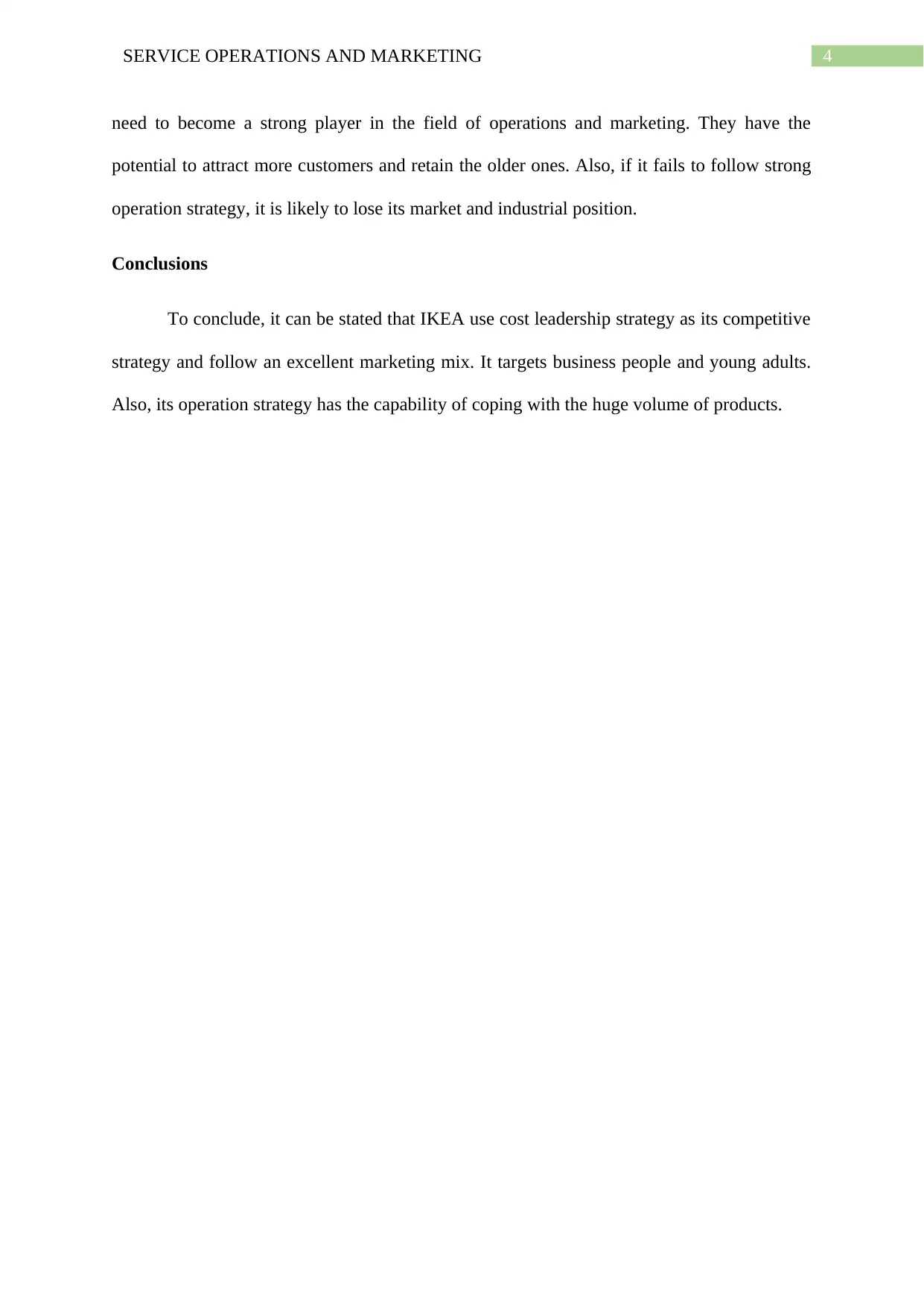
4SERVICE OPERATIONS AND MARKETING
need to become a strong player in the field of operations and marketing. They have the
potential to attract more customers and retain the older ones. Also, if it fails to follow strong
operation strategy, it is likely to lose its market and industrial position.
Conclusions
To conclude, it can be stated that IKEA use cost leadership strategy as its competitive
strategy and follow an excellent marketing mix. It targets business people and young adults.
Also, its operation strategy has the capability of coping with the huge volume of products.
need to become a strong player in the field of operations and marketing. They have the
potential to attract more customers and retain the older ones. Also, if it fails to follow strong
operation strategy, it is likely to lose its market and industrial position.
Conclusions
To conclude, it can be stated that IKEA use cost leadership strategy as its competitive
strategy and follow an excellent marketing mix. It targets business people and young adults.
Also, its operation strategy has the capability of coping with the huge volume of products.
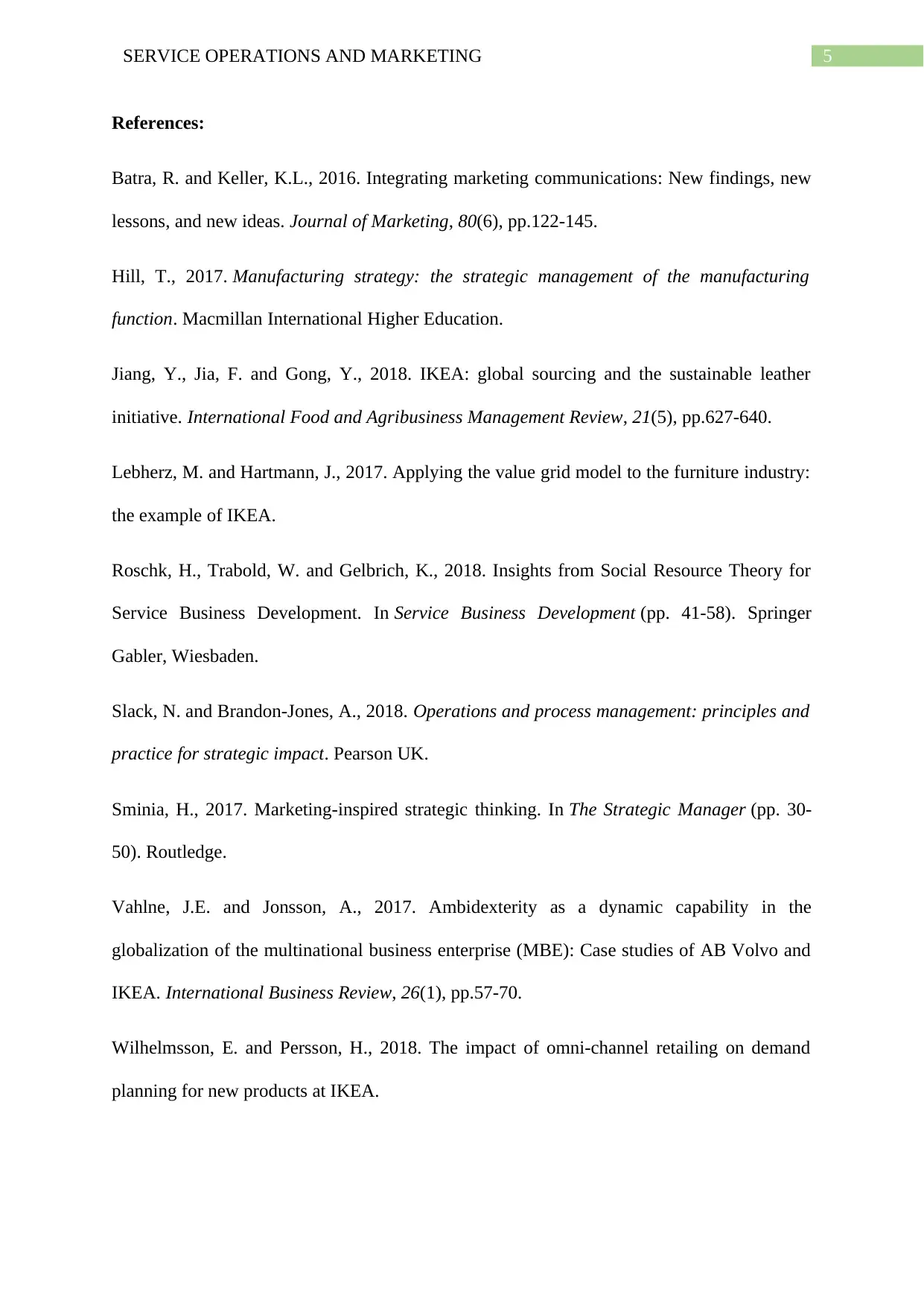
5SERVICE OPERATIONS AND MARKETING
References:
Batra, R. and Keller, K.L., 2016. Integrating marketing communications: New findings, new
lessons, and new ideas. Journal of Marketing, 80(6), pp.122-145.
Hill, T., 2017. Manufacturing strategy: the strategic management of the manufacturing
function. Macmillan International Higher Education.
Jiang, Y., Jia, F. and Gong, Y., 2018. IKEA: global sourcing and the sustainable leather
initiative. International Food and Agribusiness Management Review, 21(5), pp.627-640.
Lebherz, M. and Hartmann, J., 2017. Applying the value grid model to the furniture industry:
the example of IKEA.
Roschk, H., Trabold, W. and Gelbrich, K., 2018. Insights from Social Resource Theory for
Service Business Development. In Service Business Development (pp. 41-58). Springer
Gabler, Wiesbaden.
Slack, N. and Brandon-Jones, A., 2018. Operations and process management: principles and
practice for strategic impact. Pearson UK.
Sminia, H., 2017. Marketing-inspired strategic thinking. In The Strategic Manager (pp. 30-
50). Routledge.
Vahlne, J.E. and Jonsson, A., 2017. Ambidexterity as a dynamic capability in the
globalization of the multinational business enterprise (MBE): Case studies of AB Volvo and
IKEA. International Business Review, 26(1), pp.57-70.
Wilhelmsson, E. and Persson, H., 2018. The impact of omni-channel retailing on demand
planning for new products at IKEA.
References:
Batra, R. and Keller, K.L., 2016. Integrating marketing communications: New findings, new
lessons, and new ideas. Journal of Marketing, 80(6), pp.122-145.
Hill, T., 2017. Manufacturing strategy: the strategic management of the manufacturing
function. Macmillan International Higher Education.
Jiang, Y., Jia, F. and Gong, Y., 2018. IKEA: global sourcing and the sustainable leather
initiative. International Food and Agribusiness Management Review, 21(5), pp.627-640.
Lebherz, M. and Hartmann, J., 2017. Applying the value grid model to the furniture industry:
the example of IKEA.
Roschk, H., Trabold, W. and Gelbrich, K., 2018. Insights from Social Resource Theory for
Service Business Development. In Service Business Development (pp. 41-58). Springer
Gabler, Wiesbaden.
Slack, N. and Brandon-Jones, A., 2018. Operations and process management: principles and
practice for strategic impact. Pearson UK.
Sminia, H., 2017. Marketing-inspired strategic thinking. In The Strategic Manager (pp. 30-
50). Routledge.
Vahlne, J.E. and Jonsson, A., 2017. Ambidexterity as a dynamic capability in the
globalization of the multinational business enterprise (MBE): Case studies of AB Volvo and
IKEA. International Business Review, 26(1), pp.57-70.
Wilhelmsson, E. and Persson, H., 2018. The impact of omni-channel retailing on demand
planning for new products at IKEA.
⊘ This is a preview!⊘
Do you want full access?
Subscribe today to unlock all pages.

Trusted by 1+ million students worldwide
1 out of 6
Related Documents
Your All-in-One AI-Powered Toolkit for Academic Success.
+13062052269
info@desklib.com
Available 24*7 on WhatsApp / Email
![[object Object]](/_next/static/media/star-bottom.7253800d.svg)
Unlock your academic potential
Copyright © 2020–2025 A2Z Services. All Rights Reserved. Developed and managed by ZUCOL.





